Creating Triggers
- Click the
 (Trigger Managers) icon to view the list of existing triggers.
(Trigger Managers) icon to view the list of existing triggers.
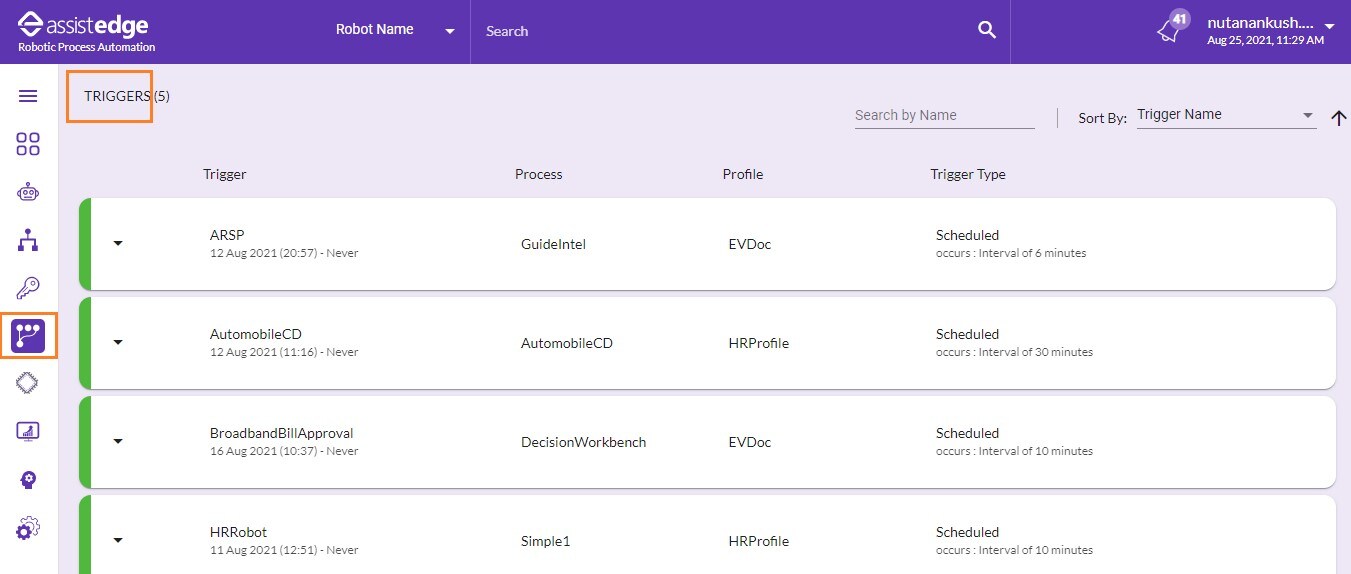
Following table contains the field description of triggers:
|
Triggers details |
Description |
|
|
Click the |
|
Trigger |
Displays the name, start date and end date for the trigger. |
|
Process |
Displays the name of process for which the trigger is created. |
|
Profile |
Displays the name of profile for which trigger is created. |
|
Trigger Type |
Displays the type of trigger whether it is schedule based or continuous monitoring. |
- Using the Search Name, you can search for the available triggers, process, profile and trigger type. For more information about Search, see Field description of Triggers.
- In the Sort By list, select the preferred option to view the trigger list accordingly. You can sort the available list as per the available sorting criteria, which includes:
- Trigger Name
- Process
- Profile
- Trigger Type
- Request Status
 (Ascending) or
(Ascending) or  (Descending) order: Click the
(Descending) order: Click the  or
or  icon to arrange the triggers in a order which it is created.
icon to arrange the triggers in a order which it is created.
- Click the
 (Add Trigger) icon to create a new trigger.
(Add Trigger) icon to create a new trigger.
.jpg)
The CREATE TRIGGER page is displayed.
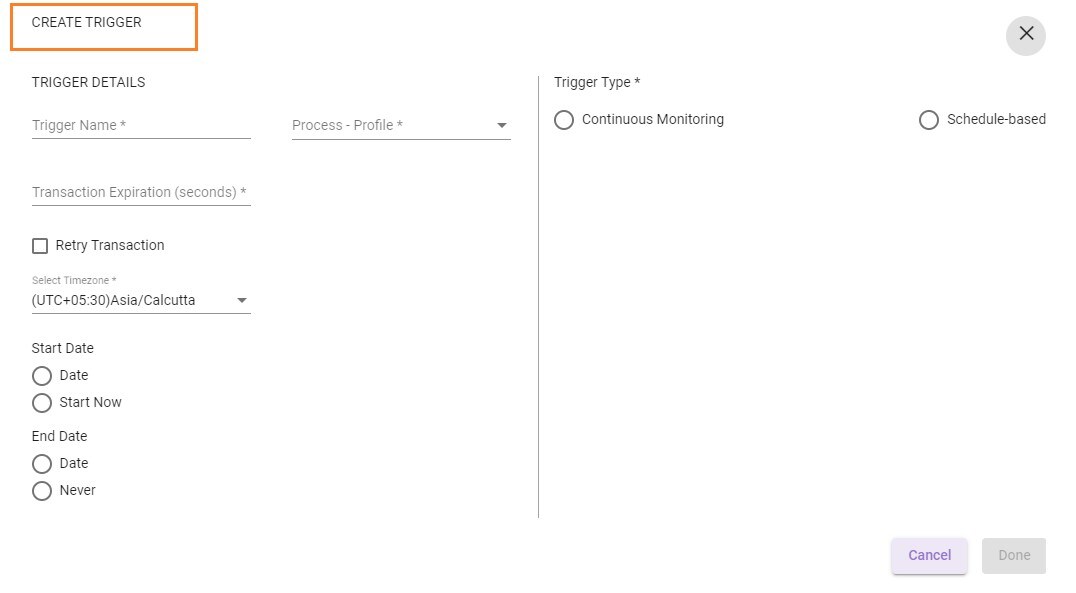
- In the TRIGGER DETAILS, enter the following details:
- In the Trigger Name field, enter unique name to identify a trigger.
- In the Process-Profile list, select the unique process-profile combination for which the request is triggered. Additionally, you can search the process from the available process list that is sorted alphabetically.
- In the Transaction Expiration (seconds) field, enter the transaction expiration seconds. The maximum value allowed is 999999 seconds.
- Select Retry Transaction check box to enable the retry capability for the request in case it gets timed out, or process execution gets an exception in a certain step while executing.
- In the Number of Retries field, enter the number of times the request is retried.
- In the Retry Interval field, enter the cool-off interval after which the request is retried.
- In the Select Time-zone, select the time zone according to which the trigger request is created and sent to RPA-Listener. Triggers can be adjusted as per preferred time zone.
- From the Start Date, select the preferred option:
- Select the Date and Time from which the request should be executed.
- Select the Start Now option, if you want to start executing the request immediately.
- From the End Date, select the preferred option:
- Select the Date and Time when the request should be stopped.
- Select the Never option, to configure to stop the monitoring until the end or for a specific time of a specific day.
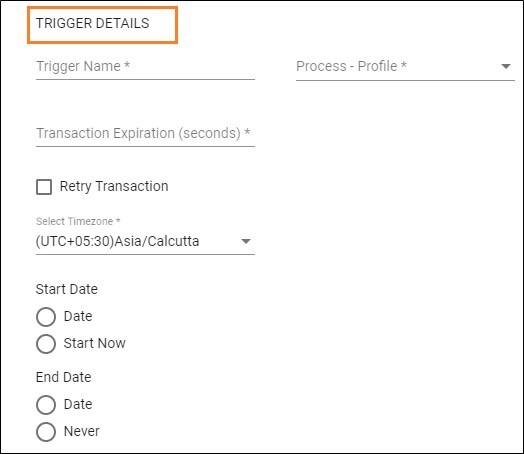
- From the TRIGGER TYPE, select the preferred option for configuring the further fields. Following are the options:
- Continuous Monitoring: Continuous monitoring triggers are that which continuously monitors a source location and sends an automation requests to the robot based on any changes that may happen at the source location.
- Schedule-based: Schedule-based triggers allows you to choose the process that has to be executed in regular intervals basis.
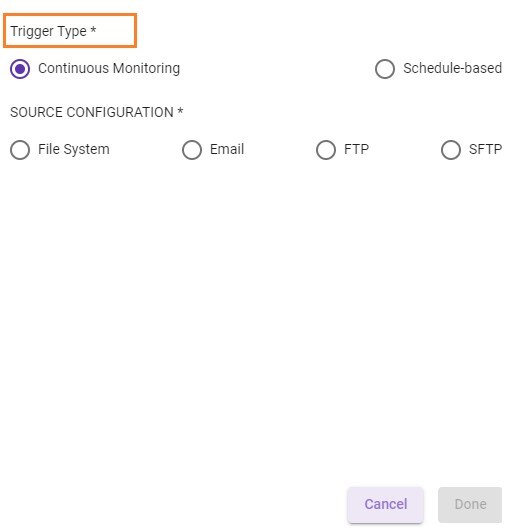
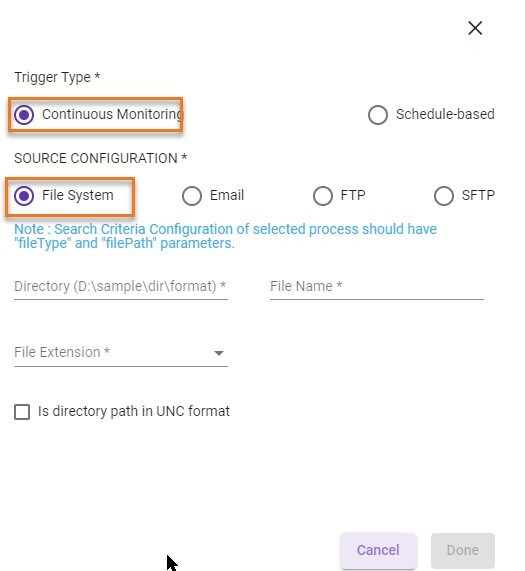
- Select the File System option, if the shared folder monitoring is selected as the trigger type, enter the following details:.
- In the Directory field, specify the shared folder path to be continuously monitored.
You can specify the IP address or network shared path in the Directory field.
For example,
IP Address: \\10.75.704.195\shared\test
Network shared path: \\demo123.ad.xyz.com\shared\test - In the File Name field, enter the name of the file to be monitored. Enter “. *” in the file name to monitor all files of a certain file type. Following are the sample of File Names:
- Any name with a specific format → “.*”
- Any specific content in between the file name → “.*(<text>).*”
- Any specific content at the end of the file name →“.*(<text>)”
- Any specific content at the start of file name →“^(<text>).*” or “(<text>).*”
- Two keywords anywhere in the file name → “.*(<char1><char2>).*”
- In the File Extension list, select the extension/type of file to be monitored. The trigger request from a file system has two process inputs.
- FileType
- FilePath
Define the corresponding process inputs in the process inputs section of the Automation Studio.
- Select the Is directory path in UNC format check box, if the shared folder is not in UNC format. .
- In the File System User ID field, enter the user ID for the file system.
- In the File System User Password field, enter the user password for the file system to open.
- In the Domain field, enter the domain details.
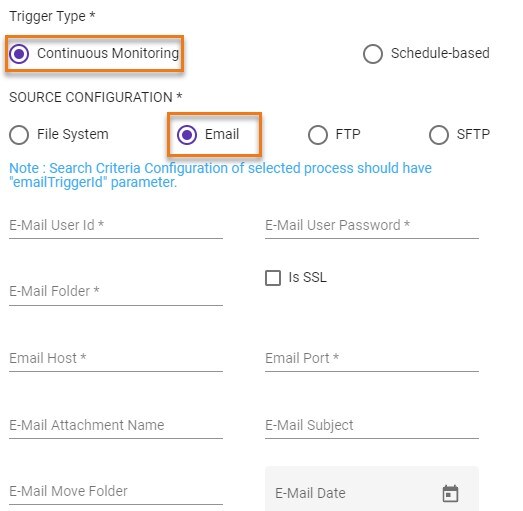
- Select the Email option.
- In the E-Mail User Id field, enter the e-mail Id of the user whose folder has to be monitored.
- In the E-Mail User Password field, enter the password to access the folder of mail box.
- In the E-Mail Folder field, enter the folder to be monitored for an incoming e-mail.
- In the E-Mail Attachment Name field, enter the email server IP address of the Enterprise E-mail server. You can configure the email host from <Container_Home>\app\RPA-ControlTower\config\ config.yml.
- Trigger request from an E-mail system has emailTriggerId as the only process input. Define the corresponding process inputs in the process inputs section of the Automation Studio.
- In the E-Mail Attachment Name field, enter the name of e-mail attachment that needs to be monitored. This is an optional field.
- In the E-Mail Subject field, enter the subject of emails that needs to be monitored. This is an optional field.
- In the E-Mail move folder field, enter the destination folder where the emails should be moved after processing. This is an optional field.
- In the E-Mail Date field, select the date post which the emails are considered for processing. This is an optional field.
- emailServerIP: IP address of the Enterprise E-mail server (configure from <Build Location>\app\RPAControlTower\config\ config.yml)
- emailServerPort: Port number for IMAP (configured from <Build Location>\app\RPAControlTower\config\config.yml)
- Trigger request from an E-mail system has emailTriggerId as the only process input.
Define the corresponding process inputs in the process inputs section of the Automation Studio.

- In the FTP User ID field, enter the ID to connect to the remote machine.
- In the FTP Password field, enter the password corresponding to FTP User ID.
NOTE:
When you edit this trigger, ensure that password field is empty.
- In the Directory field, specify the shared folder Path to be monitored continuously.
- In the File Name field, enter the name of the file to be monitored. Enter “.*” in the file name to monitor all the files of a certain file type. Following are the file name samples
- Any name with a specific format → “.*”
- Any specific content in between the file name → “.*(<text>).*”
- Any specific content at the end of the file name → “.*(<text>)”
- Any specific content at the start of file name → “^(<text>).*” or “(<text>).*”
- Two keywords anywhere in the file name → “.*(<char1><char2>).*”
- In the File Extension field, enter the extension/type of file to be monitored.
- In the FTP Host field, enter the IP address of the remote machine.
- In the FTP Port field, enter the port allocated for FTP operations on the remote machine.
- Trigger request from a file system has two process inputs:
- ftpFileType
- ftpFilePath
Define the corresponding process inputs in the process inputs section of the Automation Studio.

- In the SFTP User Id field, enter the Id used to make a connection with the remote machine.
- In the SFTP Password field, enter the password corresponding to SFTP User Id.
NOTE:
When you edit this trigger, ensure that password field is empty.
- In the Directory field, enter the shared folder path to be monitored continuously.
- In the File Name field, enter the name of the file to be monitored. If you want to monitor all files of certain type, enter “.*” in the file name. Following are the examples of File Names:
- Any name with a specific format → “.*”
- Any specific content in between the file name → “.*(<text>).*”
- Any specific content at the end of the file name → “.*(<text>)”
- Any specific content at the start of file name → “^(<text>).*” or “(<text>).*”
- Two keywords anywhere in the file name → “.*(<char1><char2>).*”
- In the File Extension field, select the extension or type of file to be monitored from the available list such as xls, pdf, csv and so on.
- In the SFTP Host field, enter the IP address of the remote machine.
- In the SFTP Port field, enter port allocated for SFTP operations on the remote machine.
- Trigger request from a file system has two process inputs.
- ftpFileType
- ftpFilePath
Define the corresponding process inputs in the process inputs section of the Automation Studio.
![]()
-
In the Schedule-based trigger type, select the preferred schedule details from the available options, such as:
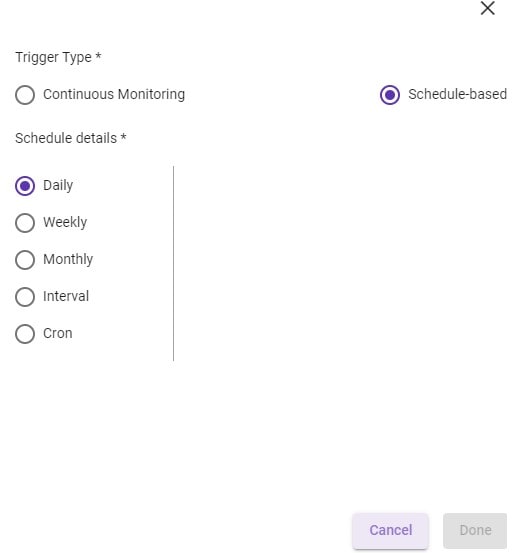
- Daily Trigger:This trigger request is triggered at Start Time every day till the End By date.
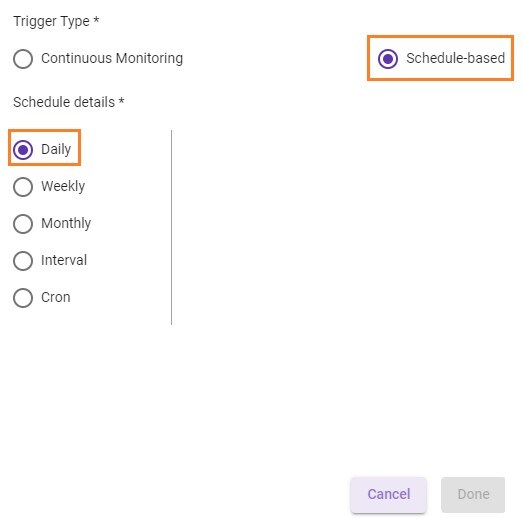
- Weekly Trigger: This trigger updates the trigger with specific days of the week along with the recurrence period.
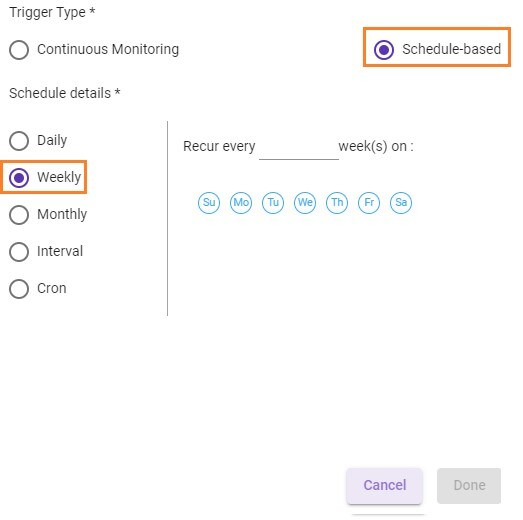
- Monthly Trigger: Triggers a request on a specific day of every month or a specific day of a specific week in every month before the configured End Date.

- Interval-based Trigger: This trigger enables you to update the trigger with Value of time and Unit of time (hours and minutes).
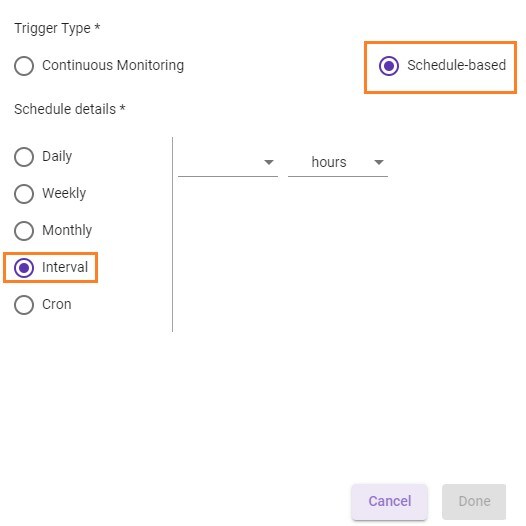
- Daily Trigger:This trigger request is triggered at Start Time every day till the End By date.
- Cron Trigger: Cron Trigger is a utility which enables you to schedule the time-based triggers that run automatically at a set time, date or after a specific interval. The field represents Minute, Hour, Day-of-Month, Month, and Day-of-Week. Click Show Definition to expand and understand the definition of the parameters to schedule the cron trigger successfully. Similarly, you can click Hide Definition to hide the details about the parameters.
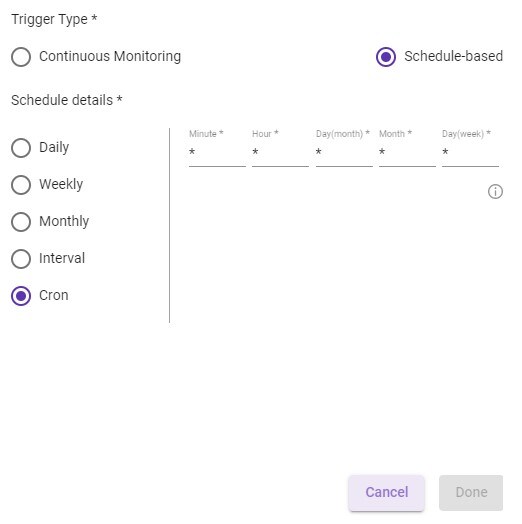
Following is the field description of Cron trigger:
| Name | Description |
| Minute | Specifies the allowed values in the minute field ( 0 to 59) when the scheduled task will run |
| Hour | Specifies the allowed values in the hours field (0 to 23) when the scheduled task will run. |
| Day (Month) | Specifies the allowed values in the Day (Month) field (1 to 31) for which the schedule task will run. Also, be careful about how many days there are in the particular month for which you are scheduling trigger |
| Month | Specifies the allowed values in the Month field (1 to 12) for which the scheduled task will run |
| Day (Week) | Specifies the allowed values in the Day (Week) field (0 to 6 (Sat-Sund)) for which the scheduled task will run. |
Following is the description of special characters which can be used to schedule the cron trigger:
| Special Characters | Description |
| * | Enables you to enter any value. "*" In this (Wild-cards) character field, you can enter every possible value |
| , | Enables you to separate the list of value |
| - | Indicates the range of values |
| / | Indicates the increment to values. For example, if you put "0/20" in the Minutes field, it means "every 20 minutes, starting at minute zero" the trigger will run. |
|
NOTE: |
In-case, invalid syntax for Cron trigger is entered then, a message appears as Invalid Cron format. |
- Click DONE.
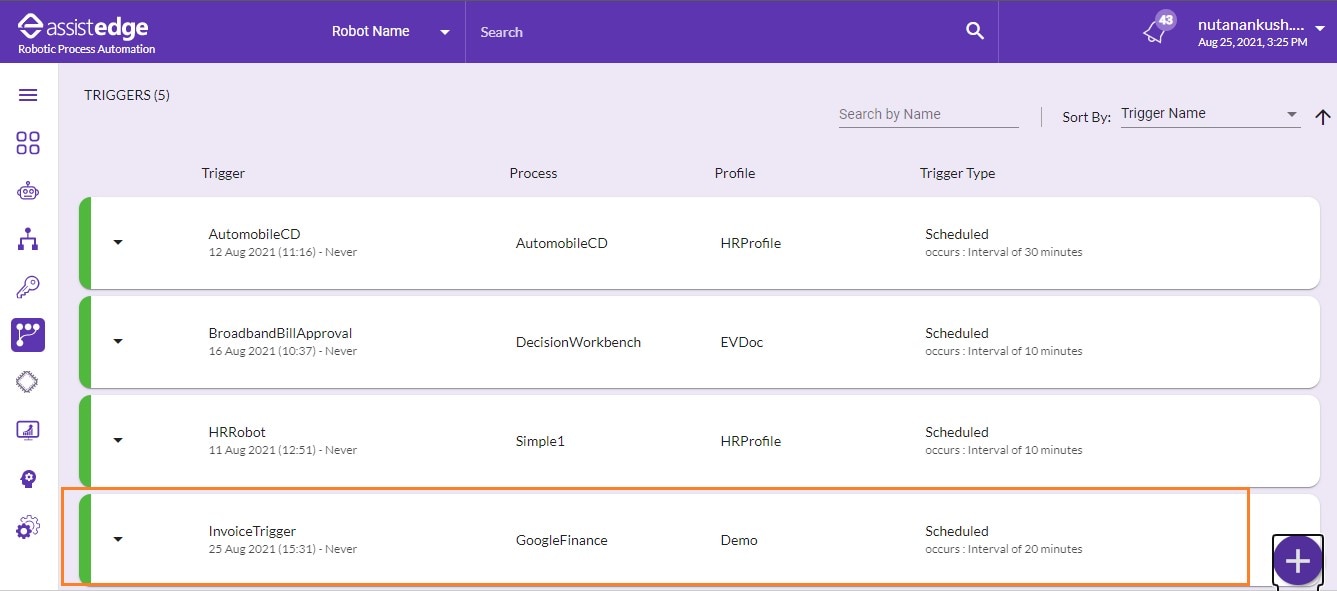
The trigger is created successfully.

Additionally, the robots will start executing the process as per the schedule type.
Deleting Existing Triggers
To delete the existing triggers:
- Select the
 (Delete) icon corresponding to existing trigger.
(Delete) icon corresponding to existing trigger.


The delete trigger message appears on the page as Would you like to delete <EmailTrigger>? For more information about search or sort by, see trigger details field description.
- Click YES to delete the trigger, else click NO to cancel the trigger deletion.
- Once the trigger is deleted, a message appears as Deleted Trigger <Trigger Name> on the page.
.jpg)
Enabling or Disabling Existing Triggers
![]() To enable or disable the existing triggers:
To enable or disable the existing triggers:
- Click the Enable/Disable Toggle button to enable or disable an existing trigger.

The Update Trigger pop-up appears with a message as Would you like to Disable <ExcelTrigger>?
For more information about search or sort by, see trigger details field description.

- Click YES to disable the trigger or else click NO to cancel the action.
|
NOTE: |
|
- Once the trigger is disabled, a message appears as Disabled Trigger <Trigger Name> on the page.

Editing Triggers
You can edit the triggers only after the trigger is disabled.
![]() To edit the disabled triggers:
To edit the disabled triggers:
- Click the
 (Edit) icon to edit the disable triggers.
(Edit) icon to edit the disable triggers.
|
NOTE: |
The edit option is enabled only for the disabled triggers. |

For more information about search or sort by, see trigger details field description.
The EDIT TRIGGER window appears.
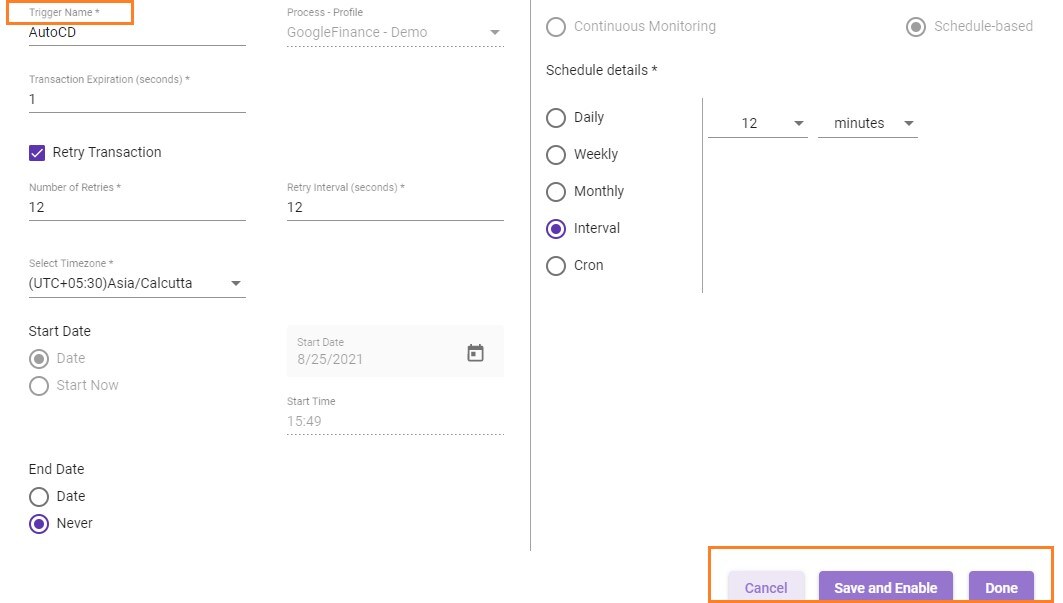
- You can edit all the fields before the configured start time. However, once the trigger is executed or passed the start time, only some fields can be edited such as Trigger Name, End by time, Transaction Expirations, Retry Trigger, Select Time-Zone, and Trigger Type.
- Once done, if you click SAVE AND ENABLE, then all the changes done will be saved and trigger will be enabled. Whereas, if you click DONE, the changes will be saved but the trigger state will be still in the existing state i.e. disabled state.

A message appears as Enabled or Updated Trigger <Trigger Name> on the page.
Filtering Triggers
You can filter the triggers according to process, profile, and trigger type as per your preference.
|
NOTE: |
Filter icon is enabled only after hovering the mouse over the particular column. This option is applicable for Process, Profile and Trigger type column. |
![]() To filter the triggers:
To filter the triggers:
- As per preference, hover the mouse next to particular field for which you want to apply filter. The filter icon appears next to column.

- Click the
 (Filter) icon and then, the list of all the process used in the triggers appears.
(Filter) icon and then, the list of all the process used in the triggers appears. - Specify the name of process or select the check box corresponding to preferred process.
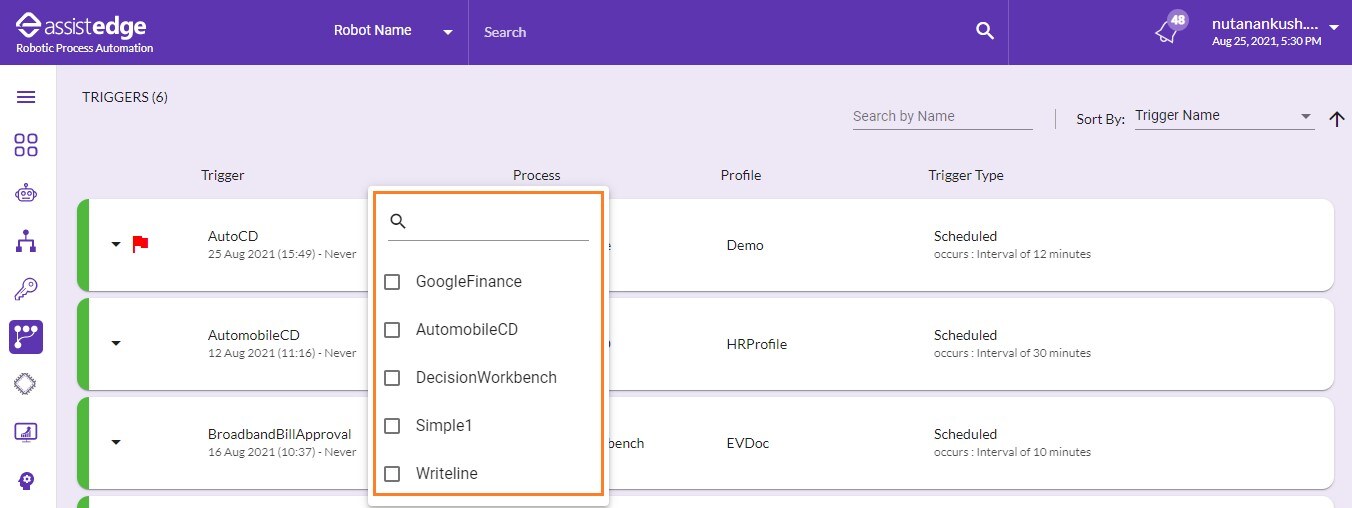
Then, the selected process is filtered from the list of process and shown on the page.
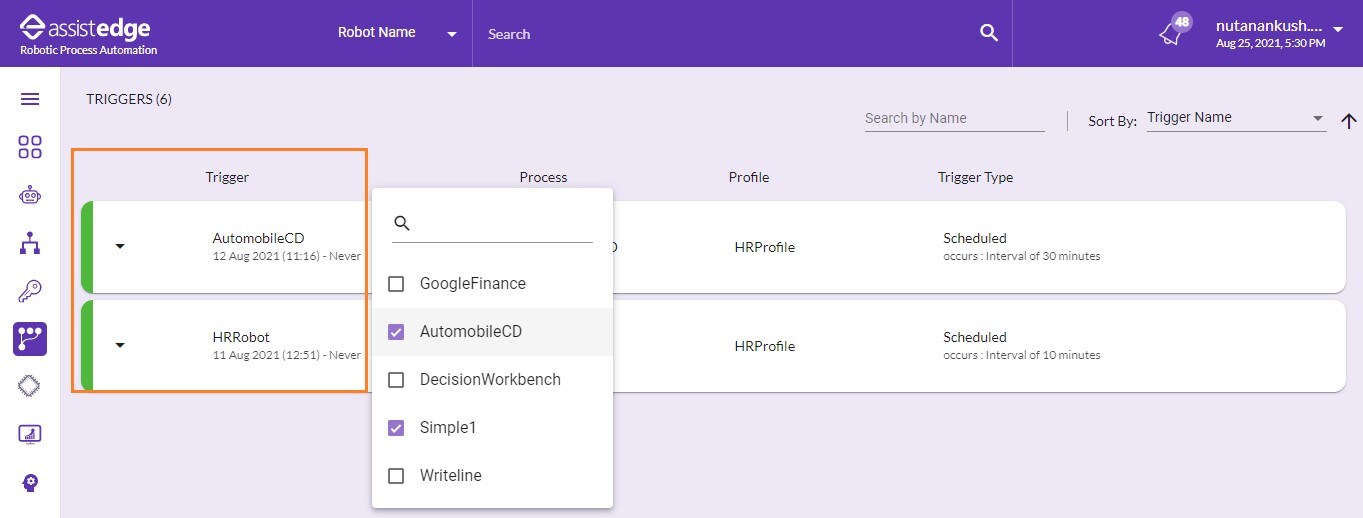
Enabling DST support for triggers
AssistEdge RPA 19.0 provides Daylight Saving Time support for triggers.
To enable the DST support for triggers:
-
Verify the Date and Time settings on your server machine. It must support DST time zones.
- Press Windows key on your machine and search Date and Time setting.
The Date and Time dialog box appears. - Click Change time zone.
- In the Time Zone Settings window, select the required time zone from the list and click OK.
For example, (UTC-06:00) Central Time (US & Canada)
NOTE:
Ensure that the Automatically adjust clock for Daylight Saving Time option is selected.

- Press Windows key on your machine and search Date and Time setting.
-
Create a trigger. For more information, see Creating Triggers.
-
Enter the trigger name.
-
Select the required Process-Profile.
-
Enter the transaction expiration time.
-
Select the required time zone.
NOTE:
This time zone must match with the daylight saving time zone that is selected on your machine.
-
Select the required start and end date.
-
Select the Schedule-based trigger type.
-
Select required value in the schedule details. For example, Cron.
-
Enter the schedule details as per the selected value.
-
Click Done.

-
-
Wait for trigger to run and verify the trigger status.
Specified trigger runs on the scheduled time during Daylight Saving Time.

